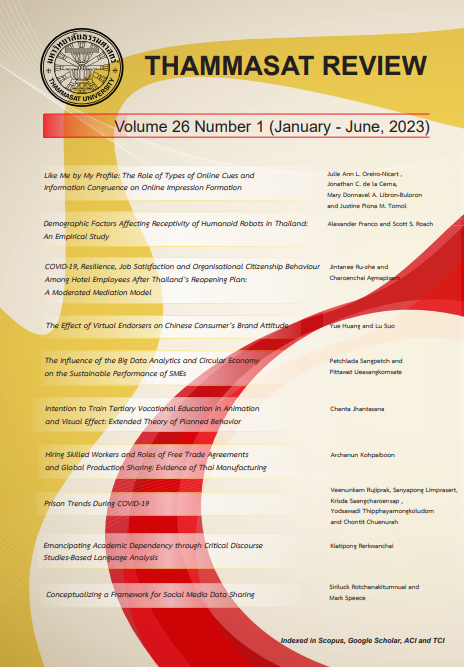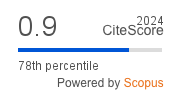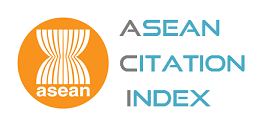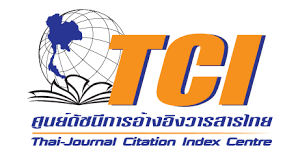Intention to Train Tertiary Vocational Education in Animation and Visual Effect: Extended Theory of Planned Behavior
Keywords:
Intension to Train, Animation and Visual Effect, Tertiary Vocational Education, Rajabhat University, Theory of Plan BehaviorAbstract
The purpose of this analysis is to examine the intention to study animation and visual effects in one-year programs using the extended theory of planned behavior (TPB) that establishes the characteristics of the program as a background variable. The background factor uses the composite model as an emergent variable, while all the others use latent variables as a common factor model in the partial least square structural equation model. The 606 sample sizes were gathered in the provinces which experienced a lower pandemic during COVID-19. The results suggest that animation and visual effects programs have a positive relationship with attitude, subjective norms, and perceived behavioral control, but no significant relationship with intention to study animation and visual effects. The attitude and subjective norms were a significantly related to the intention to study animation and visual effects in a one-year program, while perceived behavioral control did not have significant relation. This circumstance, however, increases the attractiveness of developing these types of programs at certain Rajabhat universities. There are some considerations that should be discussed in the development of tertiary vocational education of animation and visual effects, in Thailand.
References
Aguirre-Urreta, M. I., Rönkkö, M., & Marakas, G. M. (2016). Omission of causal indicators: Consequences and implications for measurement. Measurement: Interdisciplinary Research and Perspectives, 14(3), 75-97.
Ajzen, I. (1991). The theory of planned behavior. Organizational behavior and human decision processes, 50(2), 179-211.
Ajzen, I. (2002). Perceived behavioral control, self‐efficacy, locus of control, and the theory of planned behavior 1. Journal of applied social psychology, 32(4), 665-683.
Ajzen, I. (2020). The theory of planned behavior: Frequently asked questions. Human Behavior and Emerging Technologies, 2(4), 314-324.
Ajzen, I., & Fishbein, M. (1978). Use and misuse of Bayes' theorem in causal attribution: Don't attribute it to Ajzen and Fishbein either. Psychological Bulletin, 85(2), 244-246.
Ajzen, I., & Fishbein, M. (2005). The Influence of Attitudes on Behavior. In D. Albarracín, B. T. Johnson, & M. P. Zanna (Eds.), The handbook of attitudes (p. 173–221). Lawrence Erlbaum Associates Publishers. Mahwah, NJ.
Bae, S. Y., & Chang, P. J. (2021). The effect of coronavirus disease-19 (COVID-19) risk perception on behavioural intention towards ‘untact’tourism in South Korea during the first wave of the pandemic (March 2020). Current Issues in Tourism, 24(7), 1017-1035.
Bainter, S. A., & Bollen, K. A. (2015). Moving forward in the debate on causal indicators: Rejoinder to comments. Measurement: Interdisciplinary Research & Perspectives, 13(1), 63-74.
Bazan, C., Gaultois, H., Shaikh, A., Gillespie, K., Frederick, S., Amjad, A., ... & Belal, N. (2020). A systematic literature review of the influence of the university’s environment and support system on the precursors of social entrepreneurial intention of students. Journal of Innovation and Entrepreneurship, 9(1), 1-28.
Becker, J. M., Klein, K., & Wetzels, M. (2012). Hierarchical latent variable models in PLS-SEM: guidelines for using reflective-formative type models. Long range planning, 45(5-6), 359-394.
Benitez, J., Henseler, J., Castillo, A., & Schuberth, F. (2020). How to perform and report an impactful analysis using partial least squares: Guidelines for confirmatory and explanatory IS research. Information & Management, 57(2), 103-168.
Beran, R., & Srivastava, M. S. (1985). Bootstrap tests and confidence regions for functions of a covariance matrix. Annals of Statistics, 13(1), 95-115.
Bollen, K. A. (1989). A new incremental fit index for general structural equation models. Sociological methods & research, 17(3), 303-316.
Bollen, K. A. (2011). Evaluating effect, composite, and causal indicators in structural equation models. Mis Quarterly, 359-372.
Bollen, K., & Lennox, R. (1991). Conventional wisdom on measurement: A structural equation perspective. Psychological bulletin 110(2): 305.
Bollen, K. A., & Bauldry, S. (2011). Three Cs in measurement models: causal indicators, composite indicators, and covariates. Psychological methods, 16(3), 265.
Blanchard, C. (2008). Understanding exercise behaviour during home-based cardiac rehabilitation: a theory of planned behaviour perspective. Canadian journal of physiology and pharmacology, 86(1-2), 8-15.
Coccari, R. L., & Javalgi, R. G. (1995). Analysis of students' needs in selecting a college or university in a changing environment. Journal of Marketing for Higher Education, 6(2), 27-40.
Cohen, J. (1988). Statistical power analysis for the behavioral sciences (2nd ed.). Hillsdale, NJ: Erlbaum.
Deloitte (2020). The Thailand Digital Transformation Survey Report 2020. https://www2.deloitte.com/content/dam/Deloitte/th/Documents/technology/th-tech-the-thailand-digital-transformation-report.pdf
Dijkstra, T. K., & Henseler, J. (2015). Consistent partial least squares path modeling. MIS quarterly, 39(2), 297-316.
Fletcher, J. M. (2012). Similarity in peer college preferences: New evidence from Texas. Social science research, 41(2), 321-330.
Fichten, C. S., Nguyen, M. N., Amsel, R., Jorgensen, S., Budd, J., Jorgensen, M., ... & Barile, M. (2014). How well does the theory of planned behavior predict graduation among college and university students with disabilities? Social Psychology of Education, 17(4), 657-685.
Fornell, C., & Larcker, D. F. (1981). Structural equation models with unobservable variables and measurement error: Algebra and statistics. Journal of Marketing Research, 18(3), 382-388.
Guerin, R. J., & Toland, M. D. (2020). An application of a modified theory of planned behavior model to investigate adolescents’ job safety knowledge, norms, attitude and intention to enact workplace safety and health skills. Journal of safety research, 72, 189-198.
Guggenheim, N., Taubman–Ben-Ari, O., & Ben-Artzi, E. (2020). The contribution of driving with friends to young drivers’ intention to take risks: An expansion of the theory of planned behavior. Accident Analysis & Prevention, 139, 105489.
Hagger, M. S., Gucciardi, D. F., & Chatzisarantis, N. L. (2017). On nomological validity and auxiliary assumptions: The importance of simultaneously testing effects in social cognitive theories applied to health behavior and some guidelines. Frontiers in psychology, 8, 1933.
Hair Jr, J. F., Hult, G. T. M., Ringle, C., & Sarstedt, M. (2016). A primer on partial least squares structural equation modeling (PLS-SEM). Sage publications.
Henseler, J. (2017). Bridging design and behavioral research with variance-based structural equation modeling. Journal of advertising, 46(1), 178-192.
Henseler, J. (2017). ADANCO 2.0. 1: user manual.
Henseler, J., Dijkstra, T. K., Sarstedt, M., Ringle, C. M., Diamantopoulos, A., Straub, D. W., ... & Calantone, R. J. (2014). Common beliefs and reality about PLS: Comments on Rönkkö and Evermann (2013). Organizational research methods, 17(2), 182-209.
Henseler, J., Ringle, C. M., & Sarstedt, M. (2015). A new criterion for assessing discriminant validity in variance-based structural equation modeling. Journal of the academy of marketing science, 43(1), 115-135.
Henseler, J., Hubona, G., & Ray, P. A. (2016). Using PLS path modeling in new technology research: Updated guidelines. Industrial management & data systems, 116(1), 2-20.
Henseler, J., & Schuberth, F. (2020). Confirmatory composite analysis. In Composite-Based Structural Equation Modeling: Analyzing Latent and Emergent Variables. Guilford Press.
Hosseini, S. S., Shamsi, M., Khorsandi, M., & Moradzadeh, R. (2021). The effect of educational program based on theory of planned behavior on promoting retinopathy preventive behaviors in patients with type 2 diabetes: RCT. BMC Endocrine Disorders, 21(1), 1-7.
Hoeksma, D. L., Gerritzen, M. A., Lokhorst, A. M., & Poortvliet, P. M. (2017). An extended theory of planned behavior to predict consumers' willingness to buy mobile slaughter unit meat. Meat science, 128, 15-23.
Hu, L. T., & Bentler, P. M. (1999). Cutoff criteria for fit indexes in covariance structure analysis: Conventional criteria versus new alternatives. Structural equation modeling: a multidisciplinary journal, 6(1), 1-55.
JobHero. (2018, April 28). Visual Effects Artist Job Description. https://www.jobhero.com/job-description/examples/graphic-web-design/visual-effects-artist.
Kim, Y., & Han, H. (2010). Intention to pay conventional-hotel prices at a green hotel–a modification of the theory of planned behavior. Journal of Sustainable Tourism, 18(8), 997-1014.
Kusumawati, A., Yanamandram, V. K. & Perera, N. (2010). University Marketing and Consumer Behavior Concerns: The Shifting Preference of University Selection Criteria in Indonesia, Asian Studies Association of Australia 18th Biennial Conference, Adelaide, Australia, 2010
Landis, R. S., Beal, D. J., & Tesluk, P. E. (2000). A comparison of approaches to forming composite measures in structural equation models. Organizational Research Methods, 3(2), 186-207.
Lee, N., Cadogan, J. W., & Chamberlain, L. (2013). The MIMIC model and formative variables: problems and solutions. AMS review, 3(1), 3-17.
Leone, L., Perugini, M., & Ercolani, A. P. (1999). A comparison of three models of attitude–behavior relationships in the studying behavior domain. European Journal of Social Psychology, 29(2‐3), 161-189.
Li, S., & Jaharuddin, N. S. (2020). Identifying the key purchase factors for organic food among Chinese consumers. Frontiers of Business Research in China, 14(1), 1-23.
Lin, H. F. (2010). Applicability of the extended theory of planned behavior in predicting job seeker intentions to use job‐search websites. International Journal of Selection and Assessment, 18(1), 64-74.
Lost Boys School of VFX. (2021, March 24). Lost Boys School of Visual Effects: The Studio That Teaches. https://lostboys-studios.com/
Lost Boys School of VFX. (2021, April 28). Advanced VFX Compositing Program: Lost Boys School of Visual Effects. https://lostboys-studios.com/advanced-visual-effects-compositing/
Lost Boys School of VFX. (2021, May 26). Effects Technical Director Program: Lost Boys School of Visual Effects. https://lostboys-studios.com/effects-technical-director-fx-td/
Maichum, P., & Peng (2016). Application of the extended theory of planned behavior model to investigate purchase intention of green products among Thai consumers. Sustainability, 8(10), 1077.
Mancha, R. M., & Yoder, C. Y. (2015). Cultural antecedents of green behavioral intent: An environmental theory of planned behavior. Journal of Environmental Psychology, 43, 145-154.
Massiera, P., Trinchera, L., & Russolillo, G. (2018). Evaluating the presence of marketing capabilities: A multidimensional, hierarchical index. Recherche et Applications en Marketing (English Edition), 33(1), 30-52.
Müller, T., Schuberth, F., & Henseler, J. (2018). PLS path modeling–a confirmatory approach to study tourism technology and tourist behavior. Journal of Hospitality and Tourism Technology, 9(3), 249-266.
Pimpa, N. (2004). The relationship between Thai students' choices of international education and their families. International Education Journal, 5(3), 352-359.
Pimpa, N., & Suwannapirom, S. (2008). Thai students’ choices of vocational education: marketing factors and reference groups. Educational Research for Policy and Practice, 7(2), 99-107.
Prasetyo, Y. T., Castillo, A. M., Salonga, L. J., Sia, J. A., & Seneta, J. A. (2020). Factors affecting perceived effectiveness of COVID-19 prevention measures among Filipinos during enhanced community quarantine in Luzon, Philippines: Integrating Protection Motivation Theory and extended Theory of Planned Behavior. International journal of infectious diseases, 99, 312-323.
Price, I., Matzdorf, F., Smith, L., & Agahi, H. (2003). The impact of facilities on student choice of university. Facilities, 21(10), 212-222.
Rigdon, E. E. (2012). Rethinking partial least squares path modeling: In praise of simple methods. Long range planning, 45(5-6), 341-358.
Rigdon, E. E. (2016). Choosing PLS path modeling as analytical method in European management research: A realist perspective. European Management Journal, 34(6), 598-605.
Ringle, C. M., Sarstedt, M., & Straub, D. W. (2012). Editor's comments: a critical look at the use of PLS-SEM in" MIS Quarterly". MIS quarterly, iii-xiv.
Rönkkö, M., McIntosh, C. N., Antonakis, J., & Edwards, J. R. (2016). Partial least squares path modeling: Time for some serious second thoughts. Journal of Operations Management, 47, 9-27.
Schuberth, F. (2020). Confirmatory composite analysis using partial least squares: Setting the record straight. Review of Managerial Science, 1-35.
Schuberth, F., Rademaker, M. E., & Henseler, J. (2020). Estimating and assessing second-order constructs using PLS-PM: the case of composites of composites. Industrial Management & Data Systems, 120(12), 2211-2241, doi:10.1108/IMDS-12-2019-0642.
Shalender, K., & Yadav, R. K. (2018). Promoting e-mobility in India: challenges, framework, and future roadmap. Environment, development and sustainability, 20(6), 2587-2607.
Shalender, K., & Sharma, N. (2021). Using extended theory of planned behaviour (TPB) to predict adoption intention of electric vehicles in India. Environment, Development and Sustainability, 23(1), 665-681.
Shanka, T., Quintal, V., & Taylor, R. (2006). Factors influencing international students' choice of an education destination–A correspondence analysis. Journal of Marketing for Higher Education, 15(2), 31-46.
Skoglund, E., Fernandez, J., Sherer, J. T., Coyle, E. A., Garey, K. W., Fleming, M. L., & Sofjan, A. K. (2020). Using the Theory of Planned Behavior to Evaluate Factors That Influence PharmD Students’ Intention to Attend Lectures. American journal of pharmaceutical education, 84(5).
Soper, D.S. (2021). A-priori sample size calculator for structural equation models [Software]. Available from https://www.danielsoper.com/statcalc
Soria-Barreto, K., Honores-Marin, G., Gutiérrez-Zepeda, P., & Gutiérrez-Rodríguez, J. (2017). Prior exposure and educational environment towards entrepreneurial intention. Journal of technology management & innovation, 12(2), 45-58.
Taylor, S., & Todd, P. (1995). Decomposition and crossover effects in the theory of planned behavior: A study of consumer adoption intentions. International journal of research in marketing, 12(2), 137-155.
Tenenhaus, M. (2008). Component-based structural equation modelling. Total quality management, 19(7-8), 871-886.
The Rookies. (2020, December 7). Best visual effects schools in the world 2020. https://discover.therookies.co/schools/best-visual-effects-schools-in-the-world/
Think Tank Training Centre. (2021, March 24). Think Tank Training Centre, Visual Effects, Games and Animation School. https://www.tttc.ca/
Tommasetti, A., Singer, P., Troisi, O., & Maione, G. (2018). Extended theory of planned behavior (ETPB): investigating customers’ perception of restaurants’ sustainability by testing a structural equation model. Sustainability, 10(7), 2580.
Tsen, C. H., Phang, G., Hasan, H., & Buncha, M. R. (2006). Going green: A study of consumers’ willingness to pay for green products in Kota Kinabalu. International Journal of Business and Society, 7(2), 40-54.
Wang, S., Fan, J., Zhao, D., Yang, S., & Fu, Y. (2016). Predicting consumers’ intention to adopt hybrid electric vehicles: using an extended version of the theory of planned behavior model. Transportation, 43(1), 123-143.
Wathanakom, N., Khlaisang, J., & Songkram, N. (2020). The study of the causal relationship between innovativeness and entrepreneurial intention among undergraduate students. Journal of Innovation and Entrepreneurship, 9(1), 1-13.
Wiriyapinit, M. (2007). Is Thai culture the right culture for knowledge management. An exploratory case study research. Chulalongkorn Review, 74, 80-90.
Yadav, R., & Pathak, G. S. (2017). Determinants of consumers' green purchase behavior in a developing nation: Applying and extending the theory of planned behavior. Ecological economics, 134,114-122.
Yannix. (2021). VFX compositors. http://jobs.yannix.com/job-positions/vfx.
Downloads
Published
How to Cite
Issue
Section
License
Copyright (c) 2023 Thammasat Review

This work is licensed under a Creative Commons Attribution-NonCommercial-NoDerivatives 4.0 International License.
The opinions and ideas expressed in all submissions published in Thammasat Review are solely that of the author(s) and do not necessarily reflect that of the editors or the editorial board.
The copyright of all articles including all written content and illustrations belong to Thammasat Review. Any individuals or organisation wishing to publish, reproduce and distribute a particular manuscript must seek permission from the journal first.








